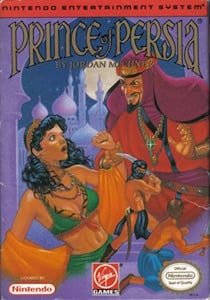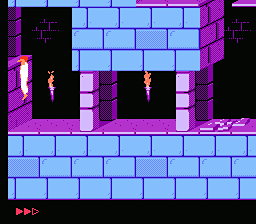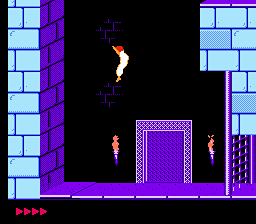
Prince of Persia (1992-)
Developer: MotiveTime
Publisher: Virgin Games | Mindscape
Genre: Platform
Prince of Persia for the NES was developed by MotiveTime and released in 1992, with Virgin Games and Mindscape sharing publishing duties in their respective territories. . The game is a side-scrolling platformer that adapts the original 1989 computer game created by Jordan Mechner, bringing the critically acclaimed cinematic action and puzzle-platforming gameplay to home console players. While the NES version features graphical and control adaptations to suit the system, it maintains the core mechanics of precision movement and timing-based challenges. There were no prequels for the NES, and the game functions as a standalone adaptation of the original Prince of Persia title.
In Prince of Persia, players control an unnamed prince who must navigate a series of dungeons and palace corridors to rescue the kidnapped princess from the evil Jaffar. The game draws inspiration from Arabian Nights tales and classic swashbuckling adventures, emphasizing agility, exploration, and tactical combat. Each level features a mix of traps, enemies, and puzzles, with a time limit adding urgency to the player’s progress. The narrative provides motivation for the precise platforming and combat encounters that define the gameplay experience.
Gameplay revolves around running, jumping, climbing, and engaging in sword fights with guards. Levels are filled with traps such as spike pits, collapsing floors, and timed doors, requiring careful observation and split-second timing to survive. Combat is strategic, with players needing to block, parry, and strike at the right moments to defeat enemies without taking excessive damage. Mastery of movement and attack timing is essential, as mistakes can be punishing and result in losing significant progress through the levels.
The soundtrack features atmospheric and suspenseful music that complements the dungeon and palace environments, while sound effects emphasize sword clashes, traps, and footsteps. Prince of Persia did not receive a direct NES sequel, but the franchise later expanded to multiple platforms and inspired a series of sequels, including Prince of Persia 2: The Shadow and the Flame. Promotion emphasized the game’s cinematic animation, challenging platforming, and engaging story, appealing to fans of action and puzzle games. Reception was positive, with critics praising the fluid animation, precise controls, and challenging level design, though some noted that the NES version’s simplified graphics and slower pacing compared to the original could affect the overall experience.
Images from MobyGames
Buy Prince of Persia
Click one of the Ebay or Amazon buttons below to check the latest prices and purchase Prince of Persia for the Nintendo Entertainment System.

Related Searches
Prince of Persia NES Download
Prince of Persia is available to purchase and download from a range of vendors. Always shop around...
Prince of Persia NES Manual
Various repositories around the internet have scanned and archived a range of retro manuals. Search now to.....
Prince of Persia NES Rom
We don't host or link to rom sites for this game. However, there are many sites out there that may be...
Prince of Persia NES Walkthrough
Many sites - particularly YouTube - host a range of walkthrough videos to guide you in your quest to get...
Prince of Persia NES Cheats
There are various sites out there that can offer cheat codes for games. Search now to find all available...
Prince of Persia NES Controls
This information can often be obtained through the user manual. Alternatively there are many sites out there...
Prince of Persia NES Release Date
The initial release date for Prince of Persia is stated as November 1992. Other ports of the game may..
Prince of Persia NES Review
There are many sites out there that have collated and documented historic reviews of this game. Search now...
Prince of Persia Famicom
As a Nintendo Entertainment System release, this game was also likely also available on the Famicom. This....
Prince of Persia NES Speedrun
There is now a community of competitive speedrunners who will try and gain the fastest possible time on their....








